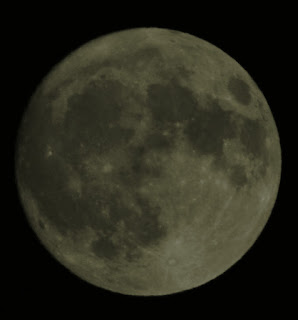November 29th 1815 GMT Deep Sky
Unfortunately, I had a bad back or I might have tried some more adventurous shots. I started with the Hyades star cluster at 70mm focal length, ISO 6400 and 6 seconds exposure but only one frame was good.
I had five frames of Melotte 20 at 300mm focal length, ISO 6400 and 2 seconds exposure but they didn't stack. I processed the best one.
I managed to stack 40 images of the Pleaides star cluster (M45).
I had five frames of Melotte 20 at 300mm focal length, ISO 6400 and 2 seconds exposure but they didn't stack. I processed the best one.
I managed to stack 40 images of the Pleaides star cluster (M45).
November 29th 1715 GMT Moon
I had another try with my DSLR at 300mm focal length. ISO 100 and 1/250 second exposure. the result was very similar.
November 29th 1605 GMT Moon
It was just after sunset and the sky was still quite bright. I snapped the Moon at 300mm focal length, ISO 400 and 1/250 second exposure.
November 19th 0650 GMT Moon
I repeated the shot from the morning before.
November 18th 1830 GMT
After arriving home from work, I set up a camera trap for
meteors. I used 16mm focal length ISO 6400 and 6 seconds exposure. I aimed at
Perseus, as I knew that several minor showers were active in that area.
I did not catch any meteors but managed a nice shot of Perseus.
I also added one of Cassiopeia.
November 18th 0645 GMT Morning Moon
The
Moon was waning gibbous and high in the sky. I took some shots at 300mm focal
length, ISO 100 and 1/1000 second exposure.
November 13th 0710 GMT Moon
November 11th 1740 GMT
November 11th 1225 GMT Mercury Transit
I just about sorted focus out before cloud rolled in and I missed first and second contact. With the Sun low down in the English autumn sky, conditions were hazy. At about 1245 GMT, I caught the tiny silloutte of Mercury near the solar limb bit you will need to use zoom to see it. I used 1540mm focal length, ISO 100 and 1/800 second exposure.
I processed a similar frame 2 minutes later but cropped the image. It was slightly out of focus.
I used a similar method at 1400 GMT and caught Mercury, with it having moved.
I tried some close-ups with my 3x Barlow but none of them worked. I also tried to see the transit using my binoculars and an eyepiece in the Mak but with no result. The transit turned out to be harder than the one I had observed many years ago.
November 8th 2200 GMT Moon
Fortunately, there was a gap in the cloud later in the
evening, so I caught the Moon with my DSLR, using the same settings as the
evening before.
November 29th 1605 GMT Moon
It was just after sunset and the sky was still quite bright. I snapped the Moon at 300mm focal length, ISO 400 and 1/250 second exposure.
November 19th 0650 GMT Moon
I repeated the shot from the morning before.
November 18th 1830 GMT
After arriving home from work, I set up a camera trap for
meteors. I used 16mm focal length ISO 6400 and 6 seconds exposure. I aimed at
Perseus, as I knew that several minor showers were active in that area.
I did not catch any meteors but managed a nice shot of Perseus.
I also added one of Cassiopeia.
November 18th 0645 GMT Morning Moon
November 13th 0710 GMT Moon
I snapped the dawn moon low in the north west. It was full.
I used my DSLR at 300mm focal length, ISO 100 and 1/1000 second exposure.
November 11th 1740 GMT
The Moon looked full, at least to camera and eyeballs. Cloud
was scattering moonlight enough to obscure all but the brightest stars. I took
some shots with DSLR at 300mm focal length, ISO 100 and 1/1000 second exposure. The quick session was much easier than the transit.
November 11th 1225 GMT Mercury Transit
I just about sorted focus out before cloud rolled in and I missed first and second contact. With the Sun low down in the English autumn sky, conditions were hazy. At about 1245 GMT, I caught the tiny silloutte of Mercury near the solar limb bit you will need to use zoom to see it. I used 1540mm focal length, ISO 100 and 1/800 second exposure.
I processed a similar frame 2 minutes later but cropped the image. It was slightly out of focus.
I used a similar method at 1400 GMT and caught Mercury, with it having moved.
I tried some close-ups with my 3x Barlow but none of them worked. I also tried to see the transit using my binoculars and an eyepiece in the Mak but with no result. The transit turned out to be harder than the one I had observed many years ago.
November 8th 2200 GMT Moon
November 8th 1750 Visual
I wish I had taken my camera with me when I was out and about on appointments. I always have my binoculars in my car boot. The Moon looked quite superb, especially around the southern craters. Sinus Iridium was away from the terminator but still prominent. I also saw Melotte 20, which only showed the brighter stars and the Perseus Double Cluster was barely visible.
November 7th 1810 GMT The Moon
I had another go at the Moon in full darkness with my DSLR at 300mm focal length, ISO 100 and 1/400 second exposure.
November 7th 1625 GMT Moon
November 7th 1440 GMT Sun
The Sun was already low down and I could only get a faint
disc in hydrogen alpha light. I took some frames more in hope than expectancy.



















No comments:
Post a Comment